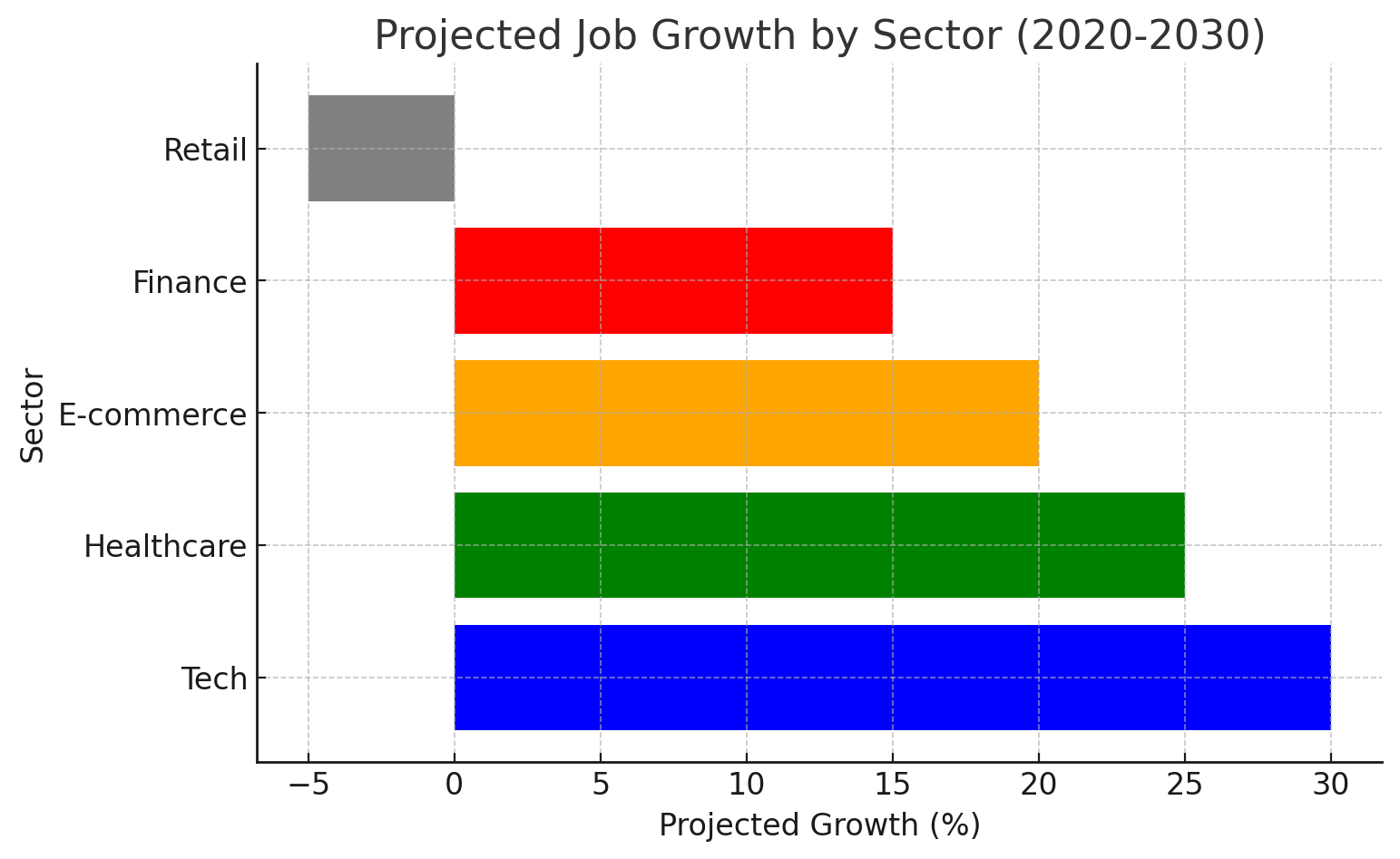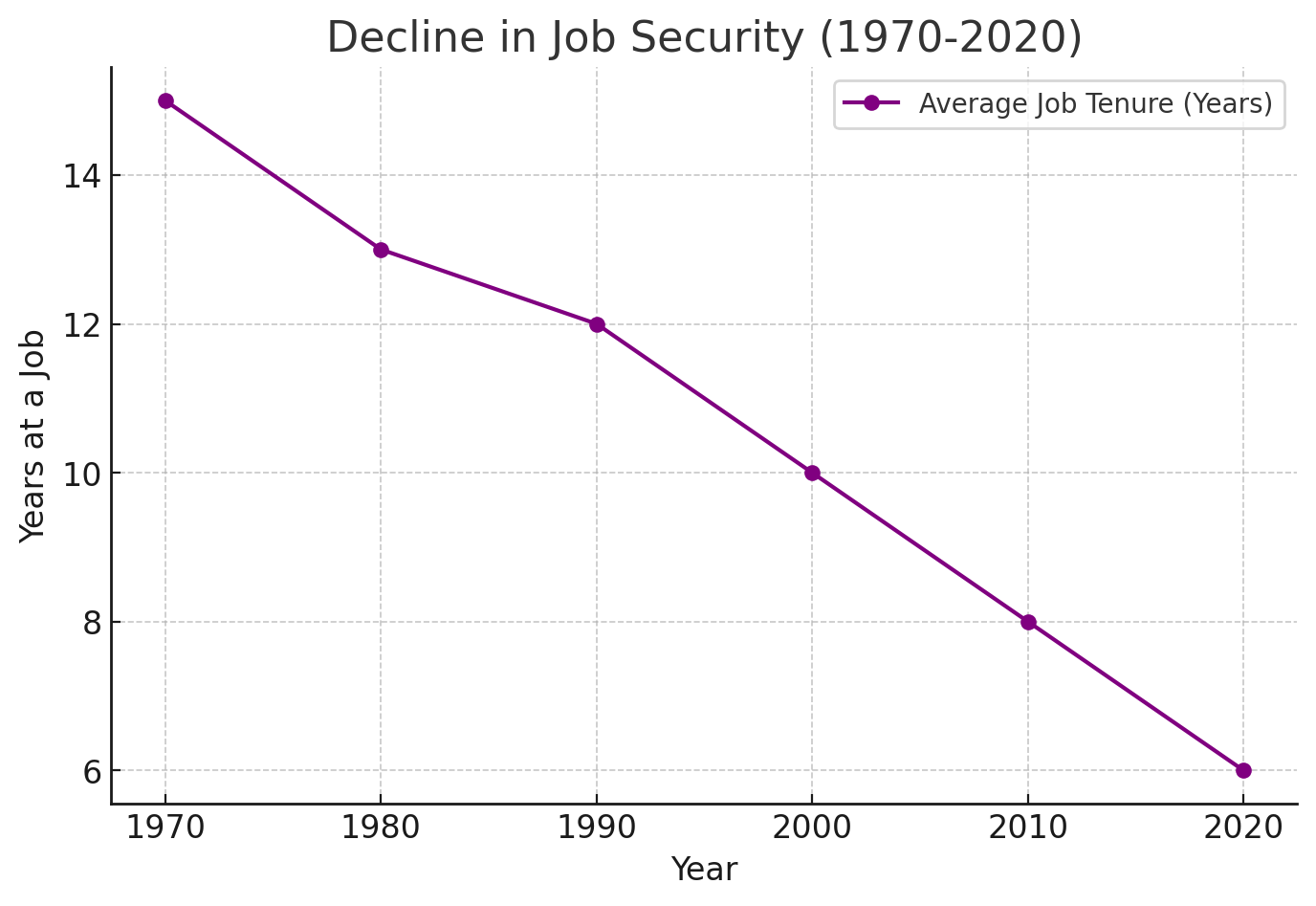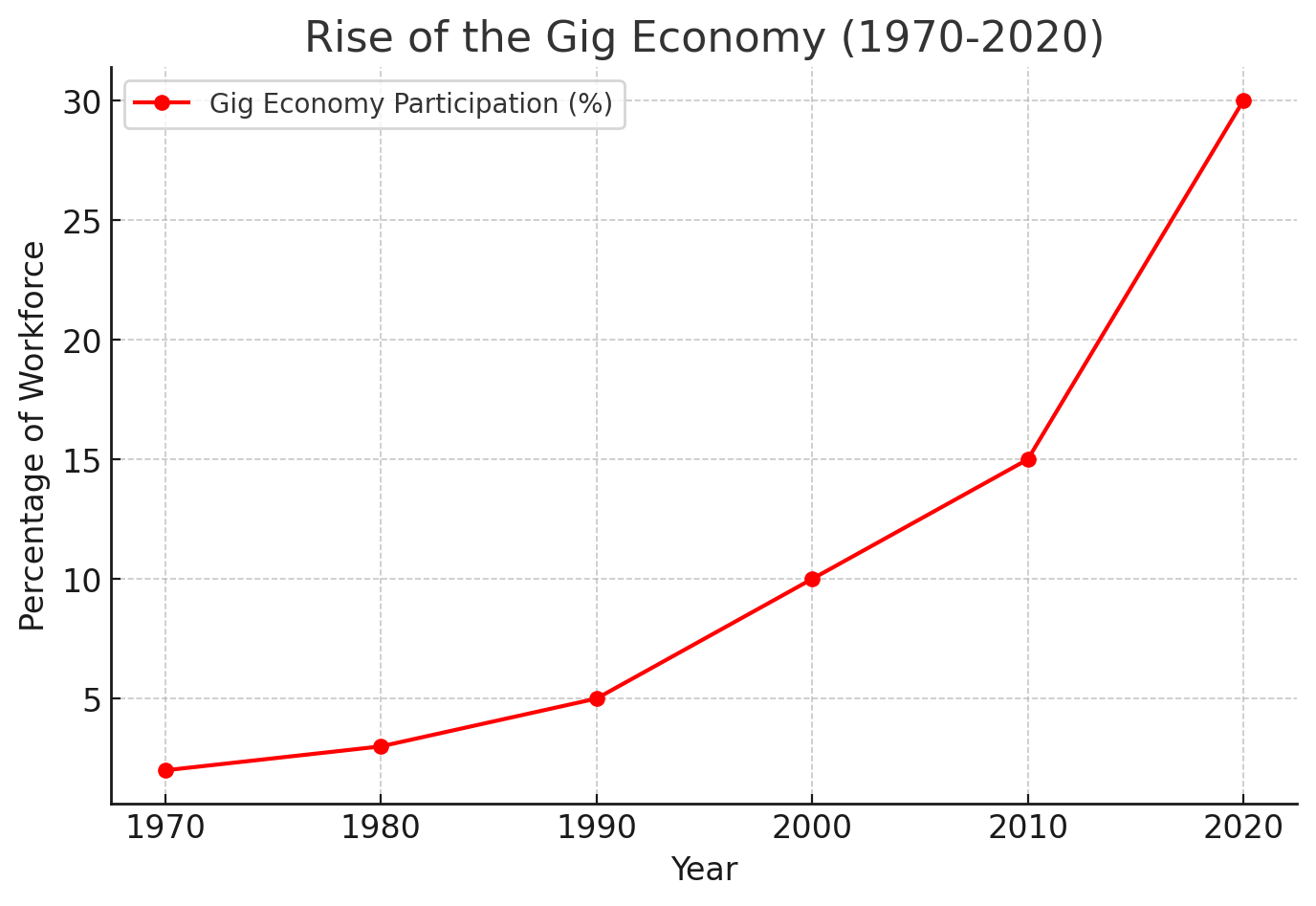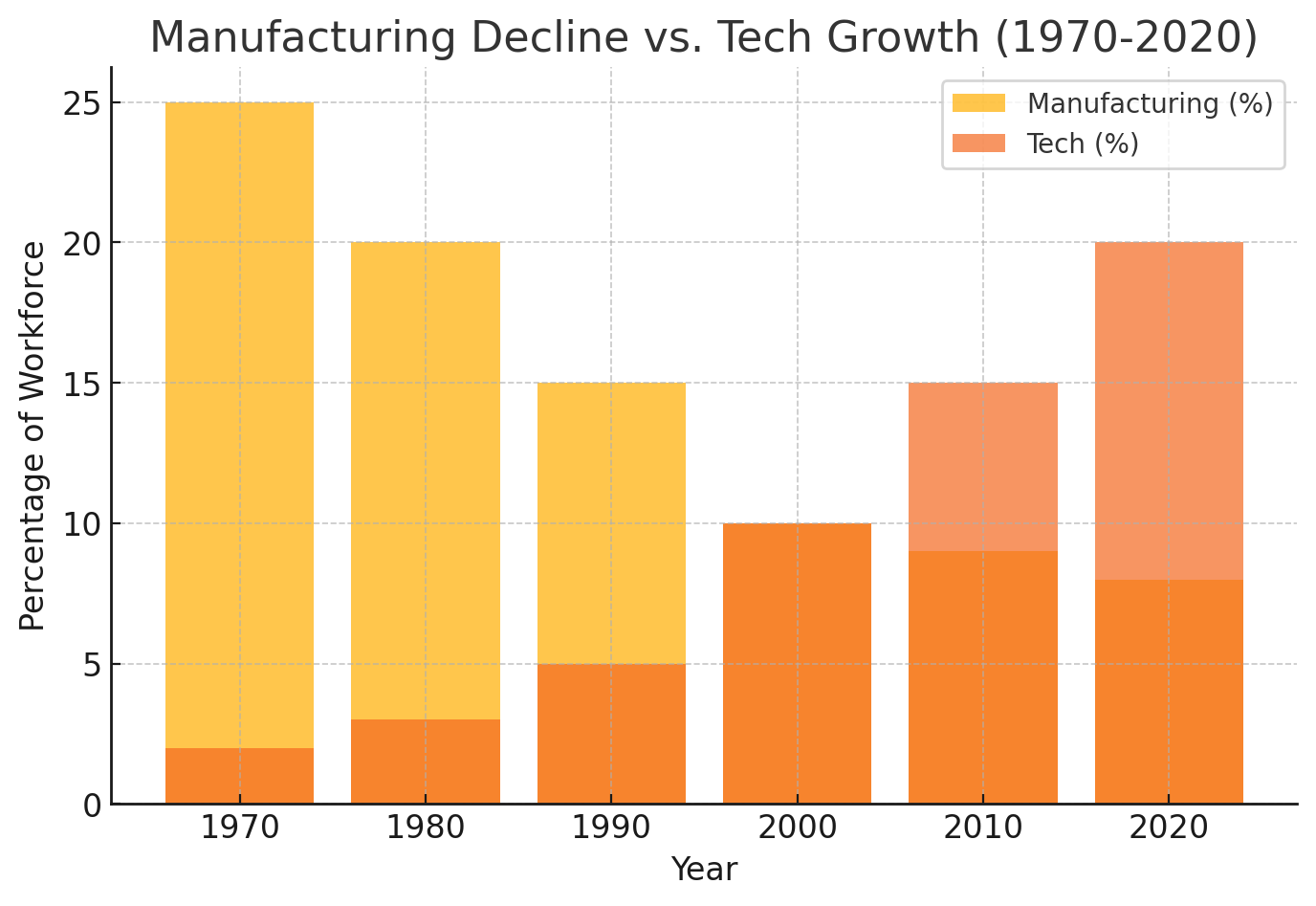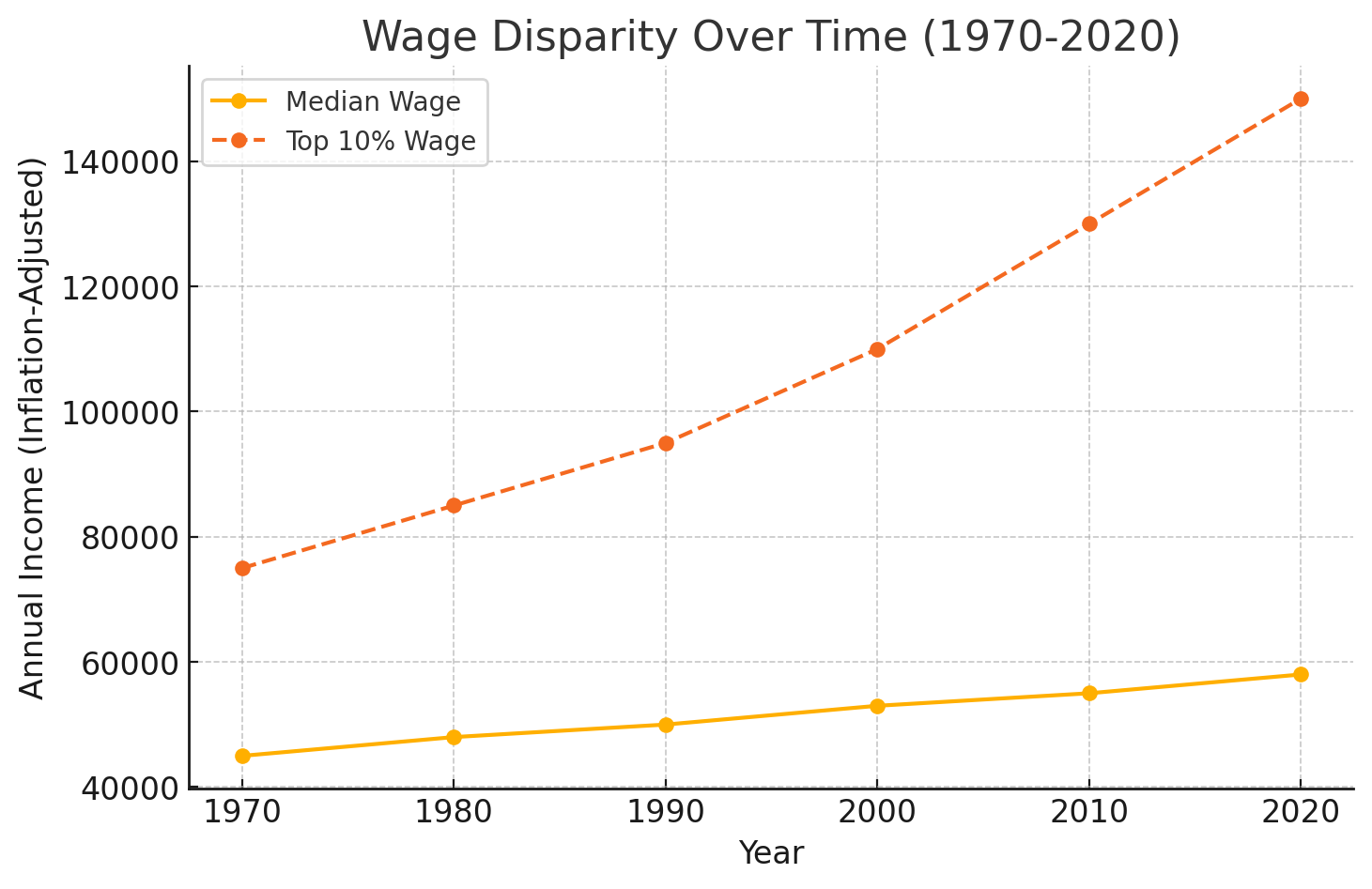
The Evolution of the American Job Market and Work History: 1970 to Today
The job market in the United States has undergone seismic shifts over the past five decades. From the manufacturing boom of the 1970s to today’s technology-driven and remote-friendly workforce, the nature of work has continuously evolved in response to economic trends, technological advancements, and global forces. Understanding this history can help us make sense of today’s job landscape and where it may be headed. A detailed employment history can significantly influence potential employers' perceptions during the job search process, aiding candidates in showcasing their qualifications, achievements, and career progression effectively.
Bountisphere is committed to you and providing great info to help you manage money better. Try us out today > app.bountisphere.com
The 1970s: The Rise and Decline of Manufacturing
In 1970, the American workforce was dominated by manufacturing and industrial jobs. The economy was strong, and companies such as General Motors, Ford, and U.S. Steel employed millions of workers in stable, well-paying union jobs. If you worked in a factory in the Midwest or on an assembly line, you were part of the backbone of the American economy.
Key Job Trends of the 1970s:
• Manufacturing dominance: Factory jobs accounted for about 25% of the U.S. workforce in the early 1970s.
• Stable middle-class wages: A high school diploma was often enough to secure a well-paying job with benefits.
• Growth of service jobs: Retail and hospitality jobs expanded, but they were still secondary to industrial work.
• Expansion of government employment: Federal, state, and local governments provided stable jobs in education, law enforcement, and public administration.
However, by the late 1970s, cracks began to appear. Inflation, oil crises, and the beginnings of globalization led to economic uncertainty. American manufacturing started facing stiff competition from Japan and Germany, setting the stage for job losses in the 1980s.
The 1980s: The Shift to a Service Economy
The 1980s marked a major turning point. As the economy shifted, having an extensive employment history became increasingly important for job applications and career advancement. The decline of manufacturing accelerated due to automation, outsourcing, and deregulation. At the same time, the financial, retail, and healthcare industries surged, shifting the economy toward service-based employment.
Key Job Trends of the 1980s:
• Decline of factory jobs: By 1985, manufacturing jobs fell below 20% of total employment.
• Rise of the financial sector: Wall Street boomed under deregulation, with investment banking and finance jobs becoming more prestigious and lucrative.
• Retail and food service expansion: Companies like Walmart, McDonald's, and fast-food chains created millions of lower-wage service jobs.
• Tech starts its rise: While not yet dominant, the early tech industry (IBM, Microsoft, and Apple) began laying the foundation for future job growth.
During this time, the wage gap widened. High-paying corporate and finance jobs flourished, but many Americans who lost manufacturing jobs had to settle for lower-wage retail or service positions.
The 1990s: The Tech Boom and Globalization
The 1990s was a decade of prosperity driven by the dot-com boom, economic expansion, and rapid technological change. A work history report is a formal document used by employers or agencies to assess an individual's work experience and career progression. Documenting a complete employment history became crucial for showcasing skills and achievements to potential employers during this period of rapid technological change. Personal computers, the internet, and mobile phones created entirely new industries.
Key Job Trends of the 1990s:
• Explosion of tech jobs: Software development, IT support, and network administration became some of the fastest-growing careers.
• Growth of healthcare: With an aging population, jobs in nursing, home healthcare, and medical technology expanded.
• Corporate America grows: The rise of massive corporations like Amazon, Google, and eBay changed retail and commerce.
• Globalization accelerates: More manufacturing jobs were outsourced to countries like China and Mexico, while international trade expanded.
Despite the growth, the dot-com bubble burst in 2000, leading to layoffs in tech. However, the internet economy was here to stay, setting the stage for the dominance of digital industries in the 21st century.
The 2000s: The Great Recession and the Gig Economy Begins
The 2000s started with a mild recession after the dot-com collapse but saw another boom fueled by housing and finance. Maintaining an accurate and updated personal employment history became essential for job applications and background checks during this period. The length of employment records requested from agencies like the Social Security Administration can affect processing fees and the level of detail provided, making it important to consider how much history is needed for verification. However, 2008’s Great Recession marked a major economic downturn, wiping out millions of jobs.
Key Job Trends of the 2000s:
• Rise of the gig economy: Platforms like Uber, Airbnb, and TaskRabbit launched, creating flexible but unstable income streams.
• Healthcare continues to grow: Aging baby boomers drove demand for nurses, doctors, and home health aides.
• Manufacturing reaches historic lows: By 2010, factory jobs accounted for only 9% of employment.
• Retail struggles: Online shopping expanded, putting pressure on traditional brick-and-mortar stores.
The 2008 financial crisis devastated jobs in finance, construction, and real estate, leading to a slow recovery that forced many into freelancing or contract work.
The 2010s: The Digital Transformation and Remote Work Revolution
The 2010s saw the rise of big tech, automation, and digital commerce. It became essential to regularly review your online records and digital footprints, such as social media profiles, to ensure your work history is accurately represented. Accurately documenting one’s work history became increasingly important as more jobs transitioned to digital and remote formats. Amazon, Google, Facebook, and Apple became dominant employers, and new technologies reshaped how people worked.
Key Job Trends of the 2010s:
• Tech industry dominance: Software engineering, cloud computing, and AI became some of the highest-paying careers.
• E-commerce jobs surge: Warehousing and logistics exploded with the rise of Amazon and online shopping.
• Social media careers emerge: Digital marketing, content creation, and influencer marketing became viable professions.
• Rise of remote work: Cloud technology allowed more people to work from home, but only in certain industries.
At the same time, automation displaced retail cashiers, customer service reps, and factory workers. The middle class continued to shrink, as well-paying jobs required more specialized skills.
2020s to Today: The Pandemic, AI, and the Future of Work
The COVID-19 pandemic in 2020 accelerated changes already underway. A comprehensive work history report became a valuable tool for job searches and background checks during this period of rapid change.
Compiling and confirming details of your working experiences is essential when building a comprehensive work history report for employment verification.
Remote work became mainstream, automation expanded, and AI began reshaping many industries.
Key Job Trends of the 2020s:
• Remote and hybrid work became the norm: Knowledge-based jobs in tech, finance, and customer service transitioned online.
• AI and automation grow: Artificial intelligence tools started replacing administrative and data-related jobs.
• Healthcare demand surges: The pandemic highlighted shortages in healthcare workers, pushing growth in nursing and telemedicine.
• Retail, restaurants, and hospitality face worker shortages: Many low-wage workers left traditional service jobs, forcing companies to offer higher wages or automate.
• Rise of AI-related careers: Jobs related to AI development, cybersecurity, and cloud computing became some of the fastest-growing.
The job market in 2025 is still evolving, with AI expected to transform roles across industries. Workers are increasingly seeking flexibility, better wages, and work-life balance, pushing companies to rethink their hiring models.
Work History and Career Development: Changing Paths, Tenure, and the Meaning of a Career
In today’s ever-evolving job market, your work history is more than just a list of previous employers—it’s a powerful narrative that can shape your career trajectory. The employment history section of your resume is often the first place potential employers look to assess your experience, skills, and reliability. As career paths become less linear and job changes more common, documenting your employment history with precision and care has never been more important.
When you change jobs or shift industries, it’s essential to keep a detailed record of your employment dates, including both start and end dates for each position. These exact dates help employers verify your work history and can be critical when explaining gaps or transitions in your career. You can access this information by contacting former employers, reviewing old pay stubs, or visiting the Social Security Administration website, which allows you to request a report of your earnings and employment records. This official documentation can be especially helpful when you need to confirm employment dates for background checks or when applying for new roles.
A comprehensive work history report should go beyond just listing jobs and dates. Include specific details about your job responsibilities, the skills you developed, and any notable achievements or awards you received. This level of detail not only demonstrates your qualifications but also helps you stand out to employers searching for top talent. If you’ve taken a break for education, family, or other reasons, use your employment history section to explain these gaps and highlight how you continued to build relevant skills during that time.
Digital tools have made it easier than ever to track and manage your employment history. Online resume builders, downloadable forms, and printable reports from the Social Security Administration can help you create a thorough and accurate record. Regularly reviewing and updating your work history ensures that you’re always ready to apply for new opportunities or respond to requests from potential employers. It’s also wise to periodically check your records for accuracy, especially if you’ve worked for multiple companies or held short-term positions.
Employers often verify work history by contacting previous employers, searching online, or using background check services. Ensuring your employment history is accurate and up-to-date can prevent delays in the hiring process and demonstrate your professionalism. If you notice any discrepancies or missing information, reach out to your former employers or the Social Security Administration to request corrections or additional documentation.
Ultimately, your employment history is a reflection of your career development and adaptability. By carefully tracking your employment dates, responsibilities, and achievements, you create a compelling story that showcases your growth and readiness for new challenges. Whether you’re applying for your first job, making a mid-career change, or seeking advancement, a well-documented work history is a critical asset in today’s competitive job market.
Remember, your work history is not just a record—it’s your career story. Take the time to ensure it’s complete, accurate, and highlights the skills and experiences that make you a valuable candidate. With the right approach, your employment history can open doors to new opportunities and help you achieve your career goals.
The Impact of Technology on Job Creation and Destruction
The rapid advancement of technology has significantly reshaped the job market, leading to both the creation of new opportunities and the obsolescence of certain roles. On one hand, technology has spurred the growth of fields such as software development, data analysis, and artificial intelligence, creating a plethora of new job opportunities. On the other hand, automation and AI have replaced many traditional jobs, rendering some positions obsolete.
According to a report by the World Economic Forum, by 2022, more than a third of the desired skills for most jobs will be comprised of skills that are not yet considered crucial today. This shift underscores the necessity for workers to continually update their skills to remain competitive in the job market.
The rise of the gig economy and online platforms has also transformed the way people work. More individuals are now engaging in freelance or contract work, which offers flexibility but often lacks the job security and benefits associated with traditional employment. This shift has created new avenues for employment but also presents challenges in terms of job stability and career progression.
Individuals can use a search engine to find online information about their previous work experience, such as profiles or resumes, which may reveal details about their employment history.
In terms of employment history, the impact of technology on job creation and destruction is evident in the evolving nature of work. As more jobs become automated, workers may need to pivot to new roles and industries, which can significantly alter their employment histories. Additionally, the prevalence of freelance and gig work can complicate the tracking of employment dates and roles, as individuals may juggle multiple short-term contracts or gigs.
Shifts in Industry and Occupation Demographics
The job market is in a constant state of flux, with significant shifts in industry and occupation demographics over the years. While some industries, like manufacturing, have seen a decline, others, such as healthcare and technology, have experienced substantial growth.
According to the Bureau of Labor Statistics, employment in the healthcare industry is projected to grow by 14% from 2020 to 2030, much faster than the average for all occupations. This growth is driven by an aging population and an increased demand for healthcare services. In contrast, the manufacturing industry is expected to see a 1% decline in employment over the same period, largely due to automation and globalization.
These shifts in industry and occupation demographics can have a profound impact on an individual’s employment history. Workers in declining industries may need to transition to new roles in growing sectors, such as healthcare or technology, which can significantly alter their career trajectories. For instance, a worker who spent years in manufacturing may need to acquire new skills to transition into a healthcare role, thereby impacting their employment history.
To navigate these changes, it is crucial for workers to stay informed about industry trends and continually update their skills. This adaptability can ensure that their employment history reflects their ability to thrive in a dynamic job market.
To find your employment history, various resources can be utilized. Government agencies, such as the Social Security Administration and state unemployment offices, can provide employment records. When requesting records, it is important to include employer names and addresses for accurate verification. You should contact former employers, credit agencies, or the Social Security office to verify or obtain your employment history. When detailing your work experience, reference department names and functions to provide a complete picture of your roles.
You can download forms and reports from official sources like the IRS or Social Security Administration websites. Employer names, addresses, and employment dates are essential for establishing a complete work history. To request and download past tax documents and employment records, use forms such as Form 4506 to file for employment history information. Official forms like Form 7050, Form W-2, and Form 4506 are required to obtain comprehensive employment history documentation. State unemployment offices can also provide employment records.
There is also the option to print forms for submission or to keep physical copies for your documentation. Individuals can receive official documents or information, such as Social Security earnings statements or work history reports, by following the appropriate procedures. Always use authoritative sources, such as credit reports or official websites, to verify employment details. Visit the official websites of the IRS or Social Security Administration to access and download the necessary documentation. Remember to include your date of birth when completing forms to accurately retrieve and verify your employment history.
In conclusion, the impact of technology on job creation and destruction, along with shifts in industry and occupation demographics, can significantly influence an individual’s employment history. By staying aware of these changes and continually updating their skills, workers can ensure that their employment history reflects their adaptability and resilience in a changing job market.
What Can We Learn From This? Insights from the Social Security Administration
Looking at the history of the American job market, a few key patterns emerge:
-
Technology drives change – The biggest shifts have come from automation, computers, the internet, and now AI.
-
Industries rise and fall – Manufacturing was king in 1970, but today, tech and healthcare lead the job market.
-
Job security has declined – Lifetime employment at a single company is rare, and more workers rely on freelancing, contract work, or gig jobs.
-
Skills matter more than ever – The most in-demand jobs today require specialized skills in tech, healthcare, and finance.
Understanding these trends can help workers adapt, reskill, and prepare for the next big changes in the job market. Verifying employment history with former employers can help ensure accurate documentation of skills and achievements.
Final Thought: Where Are We Headed in the Job Search?
With the rapid growth of AI and automation, we may see further job displacement—but also new opportunities in fields that don't yet exist. Workers who stay adaptable and continuously learn new skills will be the best positioned to succeed.
Whether you're planning a career change or just starting out, history shows that the American job market never stays the same for long. The best strategy? Stay informed, stay flexible, and take control of your financial future—which is exactly what Bountisphere is here to help you do.
%20512x512%20google%20store%20app%20logo%20SEPT%2024%2c%202025%20(4)-png.png?width=51&height=51&name=USE!!%20)%20512x512%20google%20store%20app%20logo%20SEPT%2024%2c%202025%20(4)-png.png)
